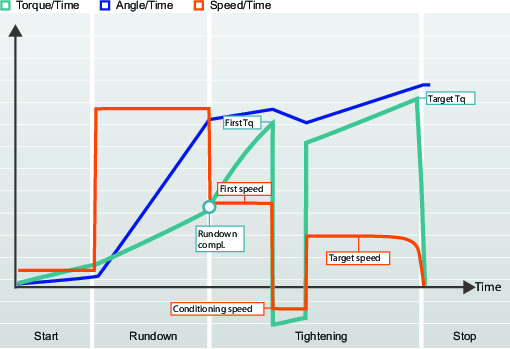Three Step
The Three step strategy adds a loosening step between the first step and the final step, to overcome short-term relaxation effects due to embedment, and reduce preload scatter. This is sometimes used to condition the joint. This can be useful in, for example, joints with many adjoining surfaces and will have a greater effect on new parts than on reused ones, due to the smoothing of surfaces, which reduces embedment.
Conditioning the joint is done by tightening the first step to a given torque, First torque, and then releasing the load by turning the nut a specified Conditioning angle and then retightening the nut to its Target torque or Target angle.
The target torque can be lower than the torque reached during the first step after rundown. In order for the target torque to be lower than the first torque, set target torque (Tightening parameters > Tightening step > Final step > Target torque) to a value lower than First torque (Tightening parameters > Tightening step > First step > First torque).
If Angle is used as a target in the tightening program, the Target angle is measured from the position at the end of the loosening step (conditioning).
Behavior of Measure torque at, and Measure angle to
The Max torque value and Value at peak torque measured under Result evaluation for Measure torque at and Measure angle to, respectively, represent the highest values measured over the entire tightening. This means that if the Target torque is set lower than the First torque, the Result evaluation value will be higher than the end value. In order to view the tightening's final value, both Measure torque at, and Measure angle to should be set to Value at shutoff.

Parameter | Description | Default value |
|---|---|---|
First torque | Torque during first step. | 80% of Target Torque |
First speed | Tool speed during first step. | 50% of Tool max speed |
Conditioning speed | Tool speed during the conditioning step. | 50% of Tool max speed |
Conditioning angle | Angle to turn the socket during the conditioning step. | 180° |
Fine-Tuning the Three Step Strategy
When the First target is reached and the conditioning step is entered, the tool makes an immediate stop and reverse before it continues with the final step. This conditioning step may need to be fine-tuned to improve ergonomics for hand-held tools.










































